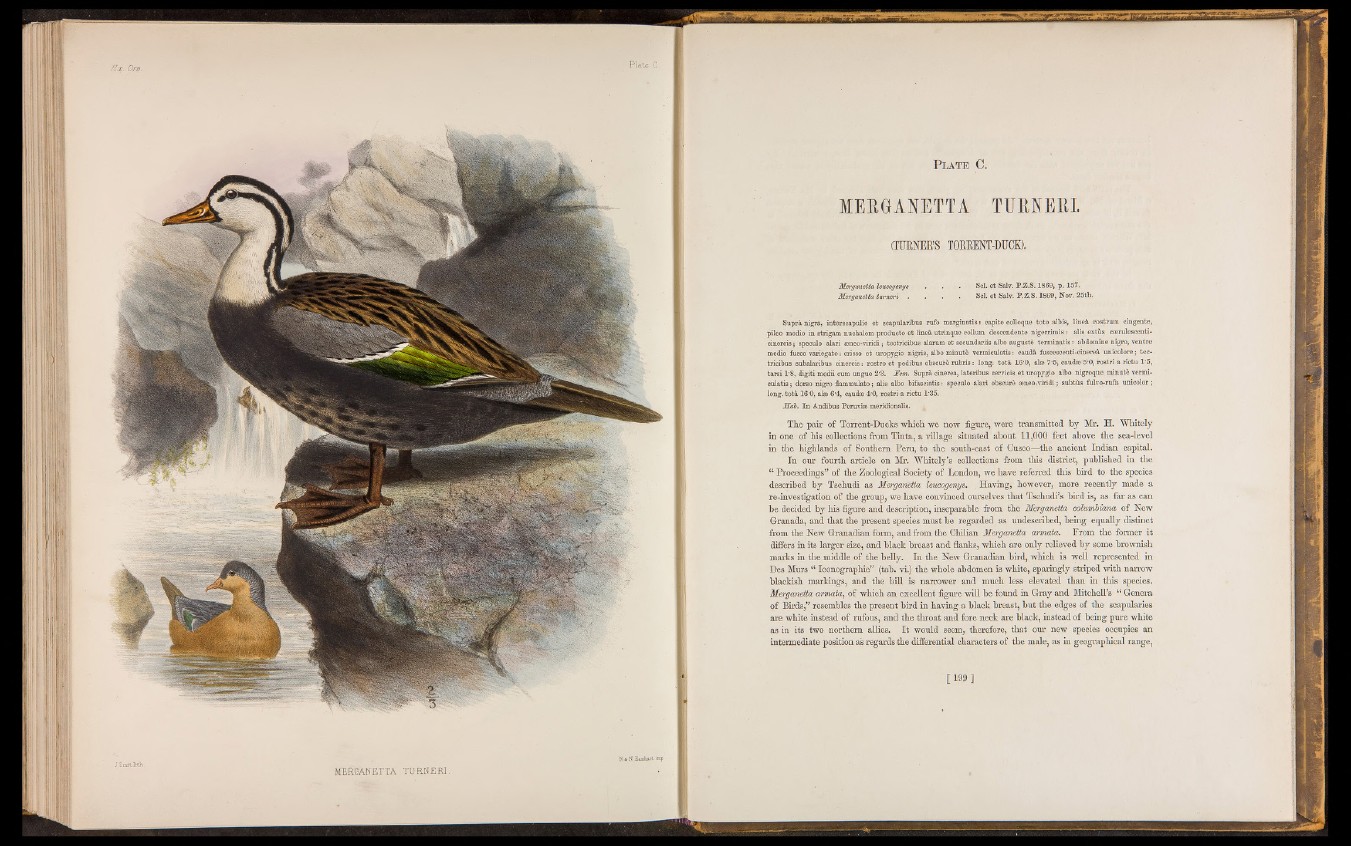
P l a t e C.
MERGANETTA TURNERI.
(TURNER’S TOERENT-DUCK).
Scl. e t Salv. P.Z.S . 1S69, p. 157.
Scl. e t Salv. P .Z Merganetta turneri .S . 1809, Nov. 2 5 th .
S u p ra nigra, in te rscap u lio e t seapularibus rufo maT^inatis ; c ap ite colloque to to albis, lin e â ro s trum ciugente,
pileo medio in strig am n u cbalem pro du cto e t liueà u trin q u e eollum descendente n ig e rrimis : alis e x tù s coerulescenti-
cin ereis; speculo a la ri æn eo -v irid i; tectric ib u a alarum e t secundariis albo auguatè te rm in a tis : abdomme nigro, v e n tre
medio fusco variegato : crisso e t uropygio n ig ris, albo min u tò v e rmicu la tis: caudà fuscescenti-cmereà u n ico lo re; te c tric
ib u s su b a laribu s ciñereis : ro stro e t p ed ib u s obscurè ru b ris : long, to t à 1 6 '0 , alæ 7 '6 , caudæ 5'0, ro s tri a r ic tu l ‘5,
ta rs i l '8 , d ig iti medii oum u n g u e 2 3. Fem. S u p rà cinerea, la te rib u s cervicis e t u ropygio albo n ig ro q u e min u tò vermicu
latis ; dorso n ig ro fiammulato ; alis albo bifasciatis : speculo a la ri obscurè æneo-viridi ; su b tù s fu lv o -ru fa un ico lo r ;
long, to tà 16 0, alæ 6-4, caudæ 4 0, ro s tri a ric tu l'3 5 .
H a i. I n Andibus Pe ru v iæ meridionalis.
The pah- o f Ton-ent-Ducks which we now figure, were transmitted by Mr. H. "Wbitely
in one o f his collections fi-om Tinta, a village situated about 11,000 feet above the sea-level
in tbe highlands o f Southern Peru, to the south-east of Cusco—the ancient Indian capital.
In our fourth article on Mr. Whitely’s collections from this disti-ict, published in the
“ Proceedings” o f the Zoological Society of London, we have referred this bird to the species
described b y Tschudi as Merganetta leucogenys. Having, however, more recently made a
re-investigation o f the group, we have convinced ourselves that Tschudi’s bird is, as far as can
be decided by his figure and description, inseparable from the Merganetta columhiana o f New
Granada, and that the present species must be regai-ded as undescribed, being equally distinct
from the New Granadian form, and from the Cliilian Merganetta armata. From the foi-mci- it
differs in its larger size, and black breast and flanks, which are only relieved h y some hrownisli
marks in the middle o f the belly. In the New Granadian bird, which is well represented in
Des Mm-s “ Iconograpliie” (tab. vi.) the whole abdomen is white, spai-ingly sti-iped with nan-ow
blackish markings, and the bill is narrower and much less elevated than in this species.
Merganetta armata, o f which an excellent figm-e will he found in Gray and îlitchelTs “ Genera
o f Birds,” resembles tbe present bird in having a black breast, but the edges o f the scapulai-ies
are white instead o f rufous, and the throat and fore neck are black, instead o f being pure white
as in its two northem allies. It would seem, therefore, that our new species occupies an
intermediate position as regards the differential characters o f the male, as in geographical range.
MERGANETTA TURNERI